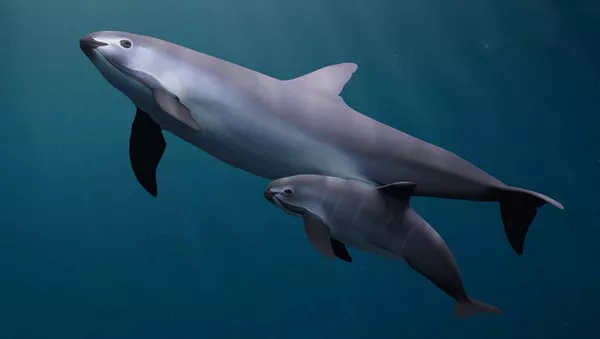Within the vast expanse of Earth’s oceans lies a diverse array of marine mammals, ranging from the colossal blue whale to the agile dolphin. Among this fascinating array of creatures, one species stands out for its diminutive size and critical conservation status: the vaquita. In this comprehensive article, we embark on a journey to explore the world of the vaquita, the smallest marine mammal on the planet. From its physical characteristics to its habitat and conservation status, join us as we delve into the intricacies of this enigmatic species.
Unveiling the Vaquita: A Profile
Physical Characteristics
The vaquita (Phocoena sinus) is a small porpoise characterized by its petite size and distinctive facial features. Adult vaquitas typically measure between 1.2 to 1.5 meters (4 to 5 feet) in length and weigh around 40 to 55 kilograms (88 to 121 pounds). Their sleek bodies are adorned with dark-gray to grayish-black coloring on their dorsal side, gradually fading to lighter shades on their ventral side.
One of the most striking features of the vaquita is its rounded head, which lacks the prominent beak seen in other porpoise species. Instead, the vaquita sports a small, slightly upturned mouth and dark eye patches, giving it a uniquely charming appearance.
Habitat and Range
The vaquita is endemic to the northern part of the Gulf of California, also known as the Sea of Cortez, off the coast of Mexico. This restricted range makes the vaquita one of the most geographically limited marine mammals in the world. Within this small area, vaquitas prefer shallow, coastal waters with depths ranging from 10 to 50 meters (33 to 164 feet).
Behavior and Diet
As elusive creatures, vaquitas are rarely seen, making it challenging for researchers to study their behavior in the wild. However, they are believed to be solitary animals, typically traveling alone or in small groups consisting of two to three individuals. Vaquitas are primarily diurnal, meaning they are most active during the day, though they may also forage during the night.
Their diet primarily consists of small fish, squid, and crustaceans, which they hunt using echolocation—a sophisticated sensory system that allows them to navigate and locate prey in murky waters.
See Also: Top 10 Smallest Pinnipeds in the World
Conservation Status
Despite its diminutive size, the vaquita faces monumental threats to its survival, pushing it perilously close to extinction. The primary factors contributing to the vaquita’s critically endangered status include:
1. Illegal Fishing Activities
The greatest threat to the vaquita’s survival is illegal fishing, particularly the use of gillnets for capturing another endangered species—the totoaba fish. The swim bladders of totoaba, highly prized in traditional Chinese medicine markets, fetch exorbitant prices on the black market. Unfortunately, vaquitas often become entangled in these illegal gillnets, leading to fatal injuries or drowning.
2. Bycatch
In addition to illegal gillnet fishing for totoaba, vaquitas also fall victim to bycatch in legal fishing operations targeting shrimp, fish, and other marine species. Despite efforts to implement vaquita-safe fishing gear, the accidental capture of vaquitas in nets remains a significant threat to their survival.
3. Habitat Degradation
Human activities, such as coastal development, pollution, and habitat degradation, further exacerbate the challenges faced by vaquitas. Destruction of mangrove forests, pollution from agricultural runoff, and increased boat traffic all contribute to the degradation of vaquita habitat, reducing their available range and exacerbating stressors on the population.
Conservation Efforts
Despite the daunting challenges facing vaquitas, conservation organizations, governments, and local communities are working tirelessly to protect this endangered species. Some of the key conservation initiatives include:
1. Vaquita Refuge Area
In an effort to safeguard vaquita habitat, a refuge area known as the Vaquita Refuge Area was established in the northern Gulf of California. This protected zone aims to provide a safe haven for vaquitas, free from the threats posed by illegal fishing activities.
2. Ban on Gillnets
In response to the vaquita’s decline, the Mexican government implemented a ban on the use of gillnets in the vaquita’s habitat. This measure seeks to eliminate the primary threat of entanglement in illegal fishing gear and reduce the risk of bycatch in legal fishing operations.
3. Conservation Awareness and Education
Conservation organizations and local communities are actively engaged in raising awareness about the plight of the vaquita and the importance of its conservation. Educational initiatives, community outreach programs, and ecotourism efforts help foster support for vaquita conservation and promote sustainable practices in the region.
Future Challenges and Opportunities
While significant efforts have been made to protect the vaquita, numerous challenges remain on the path to its recovery. Some of the key challenges and opportunities for vaquita conservation include:
1. Enforcement of Regulations
Effective enforcement of fishing regulations and anti-poaching measures is essential to combat illegal fishing activities and protect vaquita habitat. Strengthening enforcement efforts through increased patrols, surveillance, and collaboration with law enforcement agencies is critical for success.
2. Sustainable Fishing Practices
Promoting sustainable fishing practices that minimize bycatch and environmental impacts is crucial for safeguarding vaquita habitat and supporting local livelihoods. Implementing vaquita-safe fishing gear and supporting alternative livelihoods for fishing communities can help reduce the pressure on vaquita populations.
3. International Collaboration
Conserving the vaquita requires coordinated efforts on a global scale. International collaboration among governments, conservation organizations, scientists, and stakeholders is essential to address the complex challenges facing the species and ensure its long-term survival.
See Also: The Smallest Dolphin Species – The Hector’s Dolphin!
Conclusion
The vaquita, the world’s smallest marine mammal, stands at the brink of extinction, facing unprecedented threats to its survival. Illegal fishing activities, bycatch, and habitat degradation have pushed this charming porpoise to the edge of oblivion. Yet, despite the daunting challenges, there is hope for the vaquita’s survival. Through concerted conservation efforts, increased awareness, and international collaboration, we can strive to protect this endangered species and ensure that future generations have the opportunity to marvel at the beauty of the world’s smallest marine mammal.
You Might Be Interested In:



























